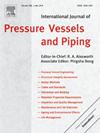Development of an experimental setup for testing X52 steel SENT specimens in electrolytic hydrogen to explore repurposing potential of pipelines
IF 3
2区 工程技术
Q2 ENGINEERING, MECHANICAL
International Journal of Pressure Vessels and Piping
Pub Date : 2025-04-09
DOI:10.1016/j.ijpvp.2025.105527
引用次数: 0
Abstract
Hydrogen is considered a key alternative to fossil fuels in the broader context of ecological transition. Repurposing natural gas pipelines for hydrogen transport is one of the challenges of this approach. However, hydrogen can diffuse into metallic lattices, leading to hydrogen embrittlement (HE). For this reason, typically ductile materials can experience unexpected brittle fractures, and it is therefore necessary to assess the HE propensity of the current pipeline network to ensure its fitness for hydrogen transport. This study examines the relationship between the microstructure of the circumferential weld joint in X52 pipeline steel and hydrogen concentration, introduced electrolytically. Base material, heat affected zone and fused zone were subjected to 1800, 3600, 7200 and 14400 s of continuous charging with a current density J = −10 mA/cm2 in an acid solution. Results showed that the fusion zone absorbed the most hydrogen across all charging times, while the base material absorbed more hydrogen than the heat-affected zone due to the presence of non-metallic inclusions. Fracture toughness was assessed using single edge notch tension specimens (SENT) in air and electrolytic hydrogen. Results indicate that the base material is particularly vulnerable to hydrogen environments, exhibiting the greatest reduction in toughness when exposed to hydrogen compared to air.
开发了一种实验装置,用于在电解氢中测试X52钢试样,以探索管道的再利用潜力
在更广泛的生态转型背景下,氢被认为是化石燃料的关键替代品。将天然气管道重新用于氢气运输是这种方法的挑战之一。然而,氢可以扩散到金属晶格中,导致氢脆(HE)。因此,典型的延性材料可能会发生意想不到的脆性断裂,因此有必要评估当前管道网络的HE倾向,以确保其适合氢气输送。本文研究了X52管线钢环焊缝组织与电解氢浓度的关系。基材、热影响区和熔接区分别在酸溶液中以电流密度J =−10 mA/cm2连续充电1800、3600、7200和14400 s。结果表明,在所有充电时间内,熔合区吸收的氢最多,而基材由于非金属夹杂物的存在,吸收的氢比热影响区多。在空气和电解氢条件下,采用单刃缺口拉伸试样(SENT)评估断裂韧性。结果表明,基材特别容易受到氢气环境的影响,与空气相比,暴露在氢气中的韧性下降幅度最大。
本文章由计算机程序翻译,如有差异,请以英文原文为准。
求助全文
约1分钟内获得全文
求助全文
来源期刊
CiteScore
5.30
自引率
13.30%
发文量
208
审稿时长
17 months
期刊介绍:
Pressure vessel engineering technology is of importance in many branches of industry. This journal publishes the latest research results and related information on all its associated aspects, with particular emphasis on the structural integrity assessment, maintenance and life extension of pressurised process engineering plants.
The anticipated coverage of the International Journal of Pressure Vessels and Piping ranges from simple mass-produced pressure vessels to large custom-built vessels and tanks. Pressure vessels technology is a developing field, and contributions on the following topics will therefore be welcome:
• Pressure vessel engineering
• Structural integrity assessment
• Design methods
• Codes and standards
• Fabrication and welding
• Materials properties requirements
• Inspection and quality management
• Maintenance and life extension
• Ageing and environmental effects
• Life management
Of particular importance are papers covering aspects of significant practical application which could lead to major improvements in economy, reliability and useful life. While most accepted papers represent the results of original applied research, critical reviews of topical interest by world-leading experts will also appear from time to time.
International Journal of Pressure Vessels and Piping is indispensable reading for engineering professionals involved in the energy, petrochemicals, process plant, transport, aerospace and related industries; for manufacturers of pressure vessels and ancillary equipment; and for academics pursuing research in these areas.

 求助内容:
求助内容: 应助结果提醒方式:
应助结果提醒方式:


